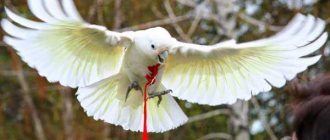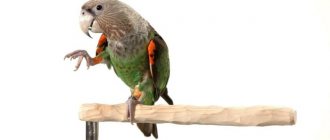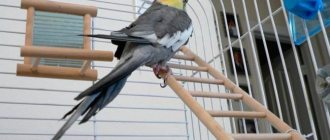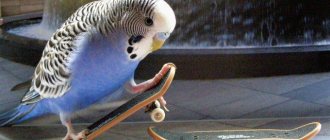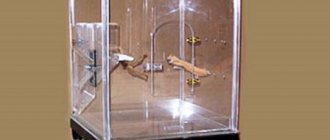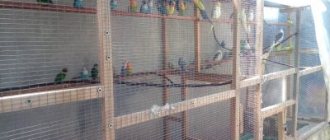Making a parrot cage with your own hands is much easier than it seems at first glance. It becomes possible to take into account all the features of keeping poultry and the parameters of the room, and choose the type, shape, and materials yourself. After reading the article, you will be able to build a cage for your feathered pet without much difficulty.
Types of cells
Conventionally, homes for birds are divided into two types - cages and aviaries.
More details about their varieties:
- Single. A small cage designed to house one small bird.
- Proletnaya. Created to accommodate entire groups of birds, often young ones. They need much more space for movement and flight, so such structures must have a length of at least four times the width.
- Standard. Designed to house one bird, but is quite capable of accommodating a couple of parrots or even a whole group of adults.
- Transportation. Designed specifically for comfortable and safe transportation of birds.
- Enclosures can be indoor or outdoor. A whole room for keeping birds, often just called very large cages. An aviary for a parrot is an ideal option for living a pet, as it allows you to create conditions as close as possible to natural ones. However, not everyone is able to afford its maintenance.
Dimensions
To independently determine what size the cage will be for one parrot or several birds, the owner must take into account the minimum dimensions of the structure.
Important: A pair of budgies requires twice as much space. Housing parameters depend on the size of the birds.
- The width of the house is calculated so that the bird can spread its wings without touching the bars.
- The height is selected taking into account free movement inside.
The length of the cage is usually at least 40 - 45 cm. With this size, two or three perches can be strengthened at different levels. The bird needs space to fly between perches without touching the bars.
The minimum cage sizes for one budgerigar and a pair of birds are summarized in the table.
| Design dimensions in centimeters | ||
| Options | For one budgie | For a couple of parrots |
| Length | 40 | 60 |
| Width | 25 | 30 |
| Height | 30 | 40 |
The arrangement of the rods should be cross: horizontal and vertical direction, and the distance between them is 10 - 15 mm.
Preparatory stage
Sizing
First you need to decide on the size of the house for your budgie. The best option for not too large breeds is a height of about a meter, length and width of about 50 centimeters. This type of housing is perfect for most varieties of parrots, but for large specimens you will have to build a larger cage.
Form
When choosing a shape, you should give preference to rectangular options. Such a home can be conveniently leaned against the wall, which can give the parrot a sense of security. A round cage is easier to clean, but it is only suitable for calm pets who are already accustomed to your home. Also, when choosing between a flat roof and an unusually shaped top, you should give preference to the first option for ease of cleaning.
In the photo below you can see what a parrot's house should be like:
Selection of materials
One of the advantages of making a bird house with your own hands is the ability to choose environmentally friendly materials yourself. Cage manufacturers often use toxic materials, metal that oxidizes quickly, and bright paint for plastic parts.
Parrots often chew on twigs and other parts of their home, so you should carefully choose the material to avoid illness in the bird. If you decide to make a cage from wood, then you should give preference to oak and ash. These rocks tolerate moisture well and are characterized by increased strength.
Required Tools
To make a bird cage with your own hands you will need wire, metal mesh, sheets of chipboard or plywood, a screwdriver, pliers, a drill, a hammer, nails, wooden slats, a file, screws, a profile and a corner.
Description
To keep a parrot in captivity, you will need certain devices that satisfy its basic needs. One of them is a bird cage, which ensures the safety of a pet in a person’s home.
On the market you can find a large number of cages of various shapes, sizes, and materials. Their prices also vary widely. There are inexpensive small models for keeping budgies or huge all-metal structures, more like indoor aviaries for large species of birds.
You can design a cage for your pet yourself, which allows you to take into account the individual characteristics of this individual. The main criteria for evaluating a product are design, size, material.
Description of homemade cages for parrots
There are the following types of housing:
- With all metal connection.
The cage is assembled from a mesh or lattice, fastened by spot welding or special devices.
A plastic or wooden frame holds a metal lattice or mesh.
- All wooden or plastic cages.
They are less common, as they are not very durable and are quickly destroyed by the strong beak of the bird. The mesh and tray are made of the same materials.
Step-by-step manufacturing instructions
To make a parrot cage with your own hands, you need to do the following.
Instructions:
- Cut a rectangle from a sheet of chipboard or plywood according to the dimensions you have chosen for the house. Nail wooden slats along the edges, which will serve as sides.
- Cut the metal profile into blanks along the length of each wall. Cut off the side part of the profile and bend the longitudinal part at an angle of ninety degrees. Measure the required amount of metal mesh according to the size of the walls.
- Attach the mesh to the manufactured frames so that there are no cracks or gaps left. Mark the intersection points. At the location of the marks, make holes with a drill that match the diameter of the wire. Bend all protruding ends of the wire inward using pliers.
- Secure the cage using corners and self-tapping screws. Make a hole for the door, make a frame from wooden slats, stretch the mesh over it and secure it. The lock can be made from wire.
- Now you can start arranging your home. It is necessary to install several perches of different sizes. Painted plastic should be avoided. They should be positioned so that nothing interferes with the parrot’s movement around the house.
- Next, you can install a mirror so that the parrot does not get bored, and a swing. You should choose the drinking bowl and feeder very carefully, paying attention to the materials. The best option is porcelain; unpainted plastic and wood are also suitable. You should not place a feeder and an open drinker under the perch.
Necessary accessories
Feeder
Feeders are made from different materials, but to avoid poisoning the bird, you need to choose non-toxic ones: clay or glass. These feeders are easy to clean and can withstand steam or boiling water.
The diameter of the feeder is ten centimeters, the height is five centimeters. Any dish of suitable size will be suitable as a feeder, as long as it is heavy. Otherwise, the bird will knock it over as soon as it sits on the side.
For the canary you need to prepare three feeders: for wet and protein food, grain and seed feed and mineral sand. For grains and seeds, it is better to choose an external wide feeder.
Then cleaning the feeder and changing food will not bother the canaries. It is advisable to avoid tall and automatic feeders. If their narrow openings become clogged with husks, the bird will not be able to reach the food and will remain hungry.
For wet and protein food, you can choose any open feeder. For mineral sand, a hinged glass feeder is suitable.
Feeders should be placed in different parts of the cage to give the bird additional exercise. You should not place feeders under the perches, otherwise droppings will get into the food. Before placing feeders in the cage, make sure there are no cracks in them. Otherwise, the canary may get hurt.
Drinking bowl
The best choice is a glass, porcelain or earthenware drinking bowl. It is advisable to choose external drinking bowls. The water will have to be changed frequently and this should not disturb the birds. Automatic drinking bowls are easy to use. The drinking bowl must be secured to the wall of the cage so that the bird can drink from it while sitting on the perch.
Bathing suit
Canaries love to swim. Therefore, every bird should have a regular opportunity to dip its feathers in warm water. In the article “Canaries: maintenance and care” we talk in detail about choosing a bathing suit.
Perches
A separate cage should have two perches (perches). When jumping from perch to perch, the canary should not touch them with its wings or tail. In nesting cages, three perches are first installed, two of them on top. When the chicks get stronger, you can install an additional perch below.
A minimum of five perches must be installed in the flight cage: two at the top, no closer than ten centimeters from the side walls, two slightly lower and closer to the middle. The latter is hung exactly in the middle, at a height of ten centimeters from the bottom of the cage.
Give preference to perches made from deciduous trees, preferably with bark. It would be good if the poles were of different thicknesses. This will prevent the canary's fingers from becoming inflamed due to friction of the same points.
Before hanging wooden perches in the cage, inspect them carefully - there should be no rotten or pest-infested areas. Be sure to treat the perches with boiling water to get rid of hidden parasites.
Additional accessories
Experts believe that canaries do not need toys, since these birds do not pay much attention to them. However, you can install a swing in the flight cage - stronger chicks may be interested in them.
You will help us a lot
, if you share the article on social networks and like it. Thank you for that.
Subscribe to our channel.
Read more stories on the Bird at Home website.
How to decorate a cage
It is worth giving preference to environmentally friendly materials. An ordinary pine cone will be an excellent decoration and toy for a bird. The parrot is able to gnaw on it for a long time. The cone can be hung on a rope or attached to one of the walls. You can also place a bunch of young branches of fruit trees in the house as a toy.
A bird house must have a mirror if you don’t want your pet to get bored. However, it is believed that birds living with a mirror will never speak because they are too fascinated by their reflection. On the other hand, the parrot will never get bored or feel lonely. You can also decorate the house with swings, badminton shuttlecocks suspended on ropes, and toys made from rings.
Features of a large bird cage
In addition to size, it is worth considering other factors in keeping large birds. Large parrots are capable of bending the bars of an ordinary house with their beak, so you should choose thick wire. Most likely, wooden cages will not be suitable, as they are not always able to withstand constant impacts and may break.
Is an aviary required?
A parrot aviary is an excellent solution for keeping a large bird or several regular-sized birds. Pets are able to fully enjoy freedom. In addition, many breeds can only reproduce in such conditions. Also, in the warm season, you can put your home on the balcony, where in the open air the parrots’ immunity is significantly strengthened and molting goes better.
Among the disadvantages is the area occupied by the enclosure. In addition, if you keep several birds in it at once, then if one of them gets sick, it may be difficult to isolate it and prevent an epidemic. Parrots living in a group are less trainable.
Features of building an aviary
When building an aviary for parrots, it is worth remembering the following features.
This:
- For ease of cleaning, you should try to make the structure collapsible. If this doesn’t work, then you need to make several doors and a fully retractable tray. It can be filled with wood cat litter, which perfectly collects dust and absorbs moisture.
- You need to place the enclosure in a bright corner of the room or place a source of artificial light nearby.
- For shy parrots, it is worth making at least two walls of the home solid.
- Rope ladders and large tree branches can be used as decoration.
Nest for budgies
During the nesting period, budgerigars living in the wild choose the hollow of an old tree as a home. Making a suitable nest at home is not so easy; you will have to meet a number of requirements. However, in order to properly set up a cage for a budgie, sooner or later you will have to place a nest inside or nearby.
Materials
A nest for budgies should be built exclusively from untreated boards. Plywood and chipboard, which contain glue and harmful resins, are not suitable.
Socket dimensions
There are three types of nests. The vertical one has dimensions of 20 by 20 centimeters and a height of about 25 centimeters. Horizontal - 25 by 50 centimeters and a height of about 15 centimeters. Compromise - dimensions 22-23 by 20 centimeters and a height of about 20 centimeters. You should choose based on the size of the cage and the area of the room.
Letok
The hole through which the bird enters the nest is called the entrance. Its diameter is usually about five centimeters, and it is placed in the upper corner of one of the walls of the home. You can install a small perch about ten centimeters in length, which extends a few centimeters into the nest, it will help the female climb inside.
Litter
An important element of the nest is a special bedding. Sawdust and small pieces of wood should be scattered around the entire perimeter of the floor. To prevent parasites from infesting there, you need to periodically sprinkle a small amount of dried chamomile.
Ventilation
For normal ventilation of the home, a few holes in the roof are sufficient. You can do them using a drill.
How to make: instructions
Before making a nest, you need to draw a drawing and cut the boards according to the selected dimensions of the house. Connect all the parts using nails and screws. Install the perch, fix the roof (so that it can later be removed for cleaning), make holes for ventilation and, if necessary, install parts for attaching the nest inside the cage.
Required Tools
- Metal grid.
- Wooden board or piece of door.
- Hammer.
- A drill or screwdriver will help make the necessary holes in the bottom.
- Scissors for working with metal.
Check it out here too!
Do-it-yourself barbecue from a gas cylinder: step-by-step instructions, choosing the optimal sizes and tips for choosing projects (110 photos)Do-it-yourself winter chicken coop: design, layout, insulation, heating. 80 photos of warm chicken coops
How to make a snow blower with your own hands: manufacturing methods, diagrams, drawings, construction options and application nuances (100 photos + video)
Advice from professionals
Professionals recommend taking into account certain features of keeping birds at home. Let's look at some of them.
So, experts advise the following:
- It is worth taking a responsible approach to choosing a location for the cage. Drafts and direct sunlight should be avoided. It is also forbidden to place the house near a radiator or heater; the parrot can easily get heatstroke. The ideal location is against the wall, near the window.
- You should not choose cells of unusual shape. Pets may feel uncomfortable and cramped in them. Avoid outdoor decorations; they interfere with the normal lighting of the home and often harbor parasites.
- For timid birds, you should choose a wooden cage; they soften the blows and prevent the pet from getting hurt.
Considering these recommendations, you can create comfortable living conditions for your feathered friend.





